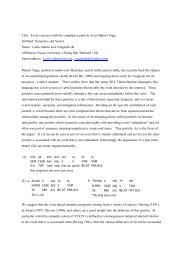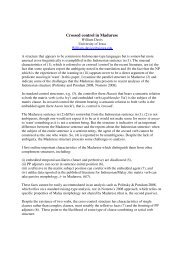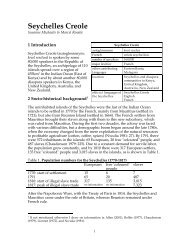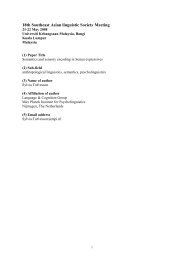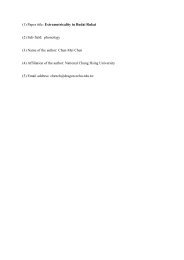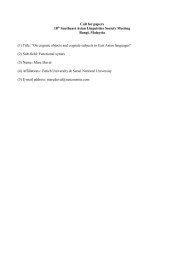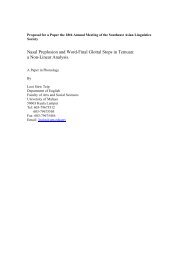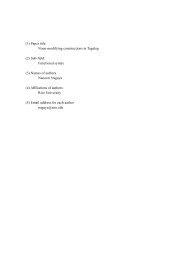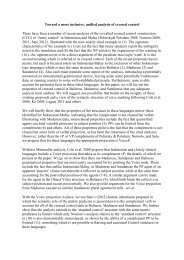Working Paper on Irrealis, Imperative Mode and Complementation ...
Working Paper on Irrealis, Imperative Mode and Complementation ...
Working Paper on Irrealis, Imperative Mode and Complementation ...
You also want an ePaper? Increase the reach of your titles
YUMPU automatically turns print PDFs into web optimized ePapers that Google loves.
Example (3):<br />
(in)-tūt-nya sa-paran ikang manuk an (m)anN-layang<br />
tinūtnya pang-layang<br />
UV2-follow-pro3 all-destinati<strong>on</strong>s DIS-DEF bird COMP AV2-fly al<strong>on</strong>g 5<br />
a. literal translati<strong>on</strong><br />
“Be followed after by him everywhere it went, that bird as it flew al<strong>on</strong>g.”<br />
b. active voice translati<strong>on</strong> in English<br />
“He followed that bird everywhere that it went, as it flew al<strong>on</strong>g.”<br />
4) VPs formed with AV2 <strong>and</strong> AV2 markers can be either transitive or intransitive. Anguhuh,<br />
“wail” in Example 1 is an example of an intransitive formed with an AV2 marker. I<br />
postulate that all VPs formed with UV2 markers are transitive, in that an (erstwhile) agent<br />
is always present in the case-frame, whether overtly expressed or not.<br />
5) Three suffixes can be added to voice-marked derivati<strong>on</strong>s. In undergoer voice these<br />
subcategorize the type of undergoer argument that is the subject of the UV verb phrase. In<br />
actor voice these suffixes subcategorize the major n<strong>on</strong>-subject complements of the VP.<br />
Based <strong>on</strong> the c<strong>on</strong>tast of transitive VPs taking no suffix with those that do take suffixes, I<br />
postulate a –Ø as <strong>on</strong>e of the three types of verbal suffixes. Disregarding the voicemarking<br />
prefixes/infixes the three possible suffixed forms of VPs are:<br />
R-an Following Adelaar <strong>and</strong> Himmelmaan (2005) I use LV (Locative<br />
Voice) to analyze –an, with the caveat that in OJ it is not involved in<br />
the formati<strong>on</strong> of a distinctive voice, but rather subcategorizes for<br />
certain types of undergoer complements. One use is cross-linguistically<br />
identical with the use noted by Himmelman (2005:373) for Tagalog,<br />
eg. to derive “designati<strong>on</strong>s for places associated with the base”.<br />
Another is to form nouns that represent the goal of the base (gamӗl, “to<br />
play a metallaph<strong>on</strong>e instrument > gamӗlan, gamelan, ensemble of<br />
metallaph<strong>on</strong>e instruments). It is important to note that in OJ –an<br />
replaces –i in undergoer voice c<strong>on</strong>structi<strong>on</strong>s (thus highlighting<br />
“locative” aspects of –i): AV umulati “look at” > UV winulatan,<br />
kawulatan, “to be looked at”<br />
R-i/ani an applicative affix that subcategorizes complements that can be<br />
described in general terms as “locative” or “stable” (see further below)<br />
5 The c<strong>on</strong>versi<strong>on</strong> of the initial bilabial nasal of a prefix to its homorganic unvoiced stop is a regular soundchange<br />
occurring following the final nasal (-n) of functi<strong>on</strong> works including negatives (tan, taman, tatan,<br />
ndatan), the c<strong>on</strong>diti<strong>on</strong>al morpheme yan <strong>and</strong> the complementizing morpheme n/an.<br />
T. Hunter, ISLOJ <str<strong>on</strong>g>Working</str<strong>on</strong>g> <str<strong>on</strong>g>Paper</str<strong>on</strong>g>, 29 May 09, page 4




